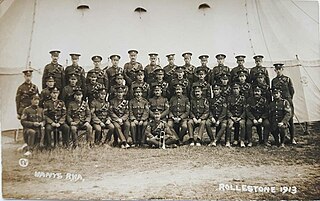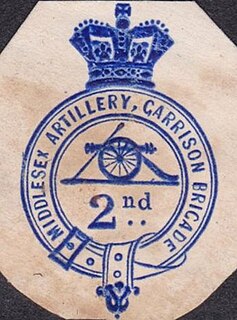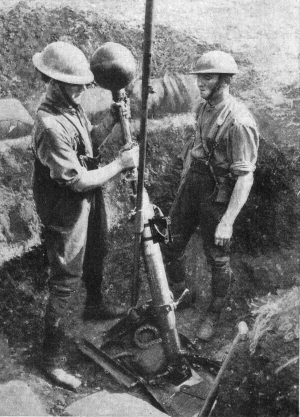
The 11th (Northern) Division, was an infantry division of the British Army during the First World War, raised from men who had volunteered for Lord Kitchener's New Armies. The division fought in the Gallipoli Campaign and on the Western Front. The division's insignia was an ankh or ankhus.

The 31st Division was an infantry division of the British Army. It was raised in the Great War by volunteers from Kitchener's Army and formed in April 1915 as part of the K4 Army Group and taken over by the War Office on 10 August 1915. Comprising mainly infantry battalions from Yorkshire and Lancashire, the division was sent to Egypt in December 1915 before moving to France in March 1916 and spent the remainder of the First World War in action on the Western Front. The 31st Division was the quintessential New Army division, being made up entirely of Pals battalions.

The 46th Division was an infantry division of the British Army, part of the Territorial Force, that saw service in the First World War. At the outbreak of the war, the 46th Division was commanded by Major-General Hon. E.J. Montagu-Stuart-Wortley. Originally called the North Midland Division, it was redesignated as the 46th Division in May 1915.

The 32nd Division was an infantry division of the British Army that was raised in 1914, during the First World War. The division was raised from volunteers for Lord Kitchener's New Armies, made up of infantry 'Pals battalions' and artillery brigades raised by public subscription or private patronage. The division was taken over by the War Office in September 1915. It served in France and Belgium in the trenches of the Western Front for the duration of the war. It saw action at the Battle of the Somme, the Pursuit to the Hindenburg Line, the Defence of Nieuport, the German spring offensive, and the Allied Hundred Days Offensive beginning at the Battle of Amiens. After the Armistice it marched into Germany as part of the Army of Occupation.

75th Division was an infantry division of the British Army in World War I. It was raised in the field by the Egyptian Expeditionary Force (EEF) in 1917 and it included British, Indian and South African troops. It served in the Middle East during the Sinai and Palestine Campaign being involved in the Battles of Megiddo.

The 58th Division was an infantry division created in 1915 as part of the massive expansion of the British Army during World War I. It was a 2nd Line Territorial Force formation raised as a duplicate of the 56th Division. After training in Britain, the division joined the British Expeditionary Force (BEF) on the Western Front in 1917. It saw action at the battles of Arras and Passchedaele in 1917 and the German spring offensive in 1918. It then took part in the Battle of Amiens and the final Allied Hundred Days Offensive of the war. The division was recreated during World War II as an imaginary 'deception' formation.

The 59th Division was an infantry division of the British Army during World War I. It was formed in late 1914/early 1915 as a 2nd Line Territorial Force formation raised as a duplicate of the 46th Division. After training in the United Kingdom and saw service in the Easter Rising in April 1916, the division joined the British Expeditionary Force (BEF) on the Western Front in early 1917. It saw action at Ypres and Cambrai, and was almost destroyed during the German Army's Spring Offensive in March 1918. The reconstituted division took part in the final advances of the war.
V Lowland Brigade, Royal Field Artillery was a field artillery brigade formed from three Territorial Force Royal Horse Artillery batteries in January 1916. It was assigned to the 52nd (Lowland) Division to replace I Lowland Brigade, RFA (T.F.) and joined the division in Egypt.

The Hampshire Royal Horse Artillery was a Territorial Force Royal Horse Artillery battery that was formed in Hampshire in 1909. It saw active service during the First World War in Egypt and Palestine from 1916 to 1918, initially as field artillery with 52nd (Lowland) Division before being converted back to horse artillery and serving with the Yeomanry Mounted Division and 1st Mounted / 4th Cavalry Division. A second line battery, 2/1st Hampshire RHA, served on the Western Front in 1917 and 1918 as part of an Army Field Artillery Brigade. Post-war, it was reconstituted as a Royal Field Artillery battery.
The Essex Royal Horse Artillery was a Territorial Force Royal Horse Artillery battery that was formed in Essex in 1908. It saw active service during the First World War in Egypt and Palestine from 1916 to 1918, initially as field artillery with 52nd (Lowland) Division before being converted back to horse artillery and serving with the 2nd Mounted / 5th Cavalry Division. A second line battery, 2/1st Essex RHA, served on the Western Front in 1917 and 1918 as part of an Army Field Artillery Brigade.
The Glamorganshire Royal Horse Artillery was a Territorial Force Royal Horse Artillery battery that was formed in Glamorganshire in 1908. It saw active service during the First World War on the Western Front in 1917 and 1918 as part of an Army Field Artillery Brigade. A second line battery, 2/1st Glamorganshire RHA, served in England and Ireland before being broken up in January 1917. Glamorganshire RHA was not reconstituted in the post-war Territorial Force.

The Leicestershire Royal Horse Artillery was a Territorial Force Royal Horse Artillery battery that was formed in Leicestershire in 1908. It saw active service during the First World War in Egypt and Palestine from 1916 to 1918, initially with ANZAC Mounted Division before joining the Yeomanry Mounted Division and 1st Mounted / 4th Cavalry Division. A second line battery, 2/1st Leicestershire RHA, served on the Western Front with the 63rd Division from 1916 to 1918. Post-war, it was reconstituted as a Royal Field Artillery battery.
The Shropshire Royal Horse Artillery was a Territorial Force Royal Horse Artillery battery that was formed in Shropshire in 1908 from the Shropshire Battery of the 1st Shropshire and Staffordshire Artillery Volunteers, Royal Garrison Artillery of the Volunteer Force. It saw active service during the First World War on the Western Front in 1917 and 1918 as part of an Army Field Artillery Brigade. A second line battery, 2/1st Shropshire RHA, also served on the Western Front in 1917 and 1918 as part of another Army Field Artillery Brigade. It was reconstituted post-war as a medium artillery battery and served as such in the Second World War.

The 1st Staffordshire Artillery Volunteers, later 2nd North Midland Brigade, was a Volunteer unit of the Royal Artillery of the British Army recruiting primarily from Staffordshire that fought on the Western Front during the First and Second World Wars in the Normandy Campaign and Belgium, Holland, and Germany.

The 2nd Middlesex Artillery was a Volunteer unit of Britain's Royal Artillery. First raised in the Victorian era among Customs officers in the Port of London, it later became the 3rd London Brigade, Royal Field Artillery in the Territorial Force and saw action on the Western Front during World War I.
The 2nd Kent Artillery Volunteers, later 4th London Brigade, Royal Field Artillery, popularly known as the Lewisham Gunners, was a volunteer unit of the British Army from 1860 until 1967. Initially raised in suburban West Kent, its recruiting area was later incorporated within the County of London. It provided two active service units in each of the World Wars, operating as far afield as Sicily, Burma and Madagascar, and later provided an airborne unit in the Territorial Army of the 1950s.

The 3rd North Midland Brigade, Royal Field Artillery was a volunteer unit of the British Territorial Force formed in 1908. It served in some of the bloodiest battles on the Western Front during World War I

The 33rd Divisional Artillery, popularly known as the Camberwell Gun Brigade, was a Royal Artillery force raised as part of 'Kitchener's Army' in early 1915. Recruited in the Borough of Camberwell, South London, the units served with the 'Pals battalions' of the 33rd Division on the Western Front for three years. They also supported other formations when 33rd Division was out of the line. The batteries saw action at the Somme, Arras, and Ypres, suffering heavy casualties. They were particularly distinguished defending against the German spring offensive of 1918, and continued through the victorious Allied Hundred Days Offensive.

The 39th (Deptford) Divisional Artillery was a Royal Artillery force raised as part of 'Kitchener's Army' in early 1915. Recruited in Deptford, South London, the units served with the 'Pals battalions' of the 39th Division on the Western Front for two years. They saw action at the Somme, Ypres, and the German spring offensive, including the Battle of the Avre, described as 'one of the finest artillery stories of the whole war'. The units then operated as an independent artillery formation during the Allied Hundred Days Offensive.

The 32nd Divisional Artillery was a Royal Artillery force raised as part of 'Kitchener's Army' in early 1915. Recruited in Yorkshire, originally for the 31st Division, the units served with the 'Pals battalions' of the 32nd Division on the Western Front for three years. They saw action at the Somme, the pursuit to the Hindenburg Line, the German spring offensive, and the Allied Hundred Days Offensive.











